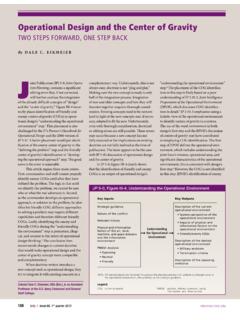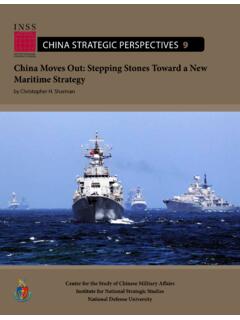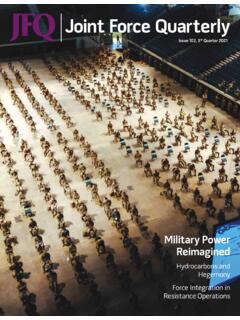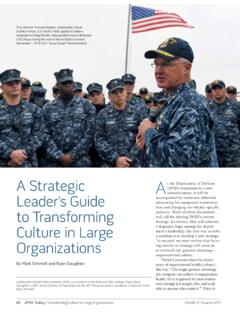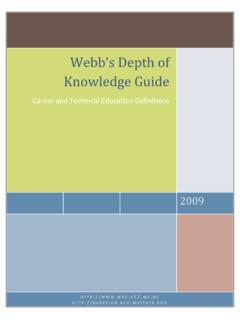Transcription of DTP 60 Operation Anaconda
1 Richard L. Kugler, Michael Baranick, and Hans Binnendijk Center for Technology and National Security Policy National Defense University March 2009 Operation Anaconda Lessons for Joint operations ii The views expressed in this article are those of the authors and do not reflect the official policy or position of the National Defense University, the Department of Defense or the Government. All information and sources for this paper were drawn from unclassified materials. This study was completed in September 2003 and circulated within the Department of Defense, underwent extensive security review, and was cleared for publication in February 2009.
2 Dr. Richard L. Kugler is a consultant with the Center for Technology and National Security Policy. His specialties are defense strategy, global security affairs, and NATO. He advises senior echelons of the Office of Secretary of Defense, the Joint Staff, and the interagency community. An operations research analyst and political scientist, he holds a from the Massachusetts Institute of Technology. Dr. Michael Baranick is a Senior Research Fellow for Modeling and Simulation Technology.
3 Dr. Baranick joined the Center after having served as the Chief of the Modeling and Simulation Branch at the National Defense University War Gaming and Simulation Center. Prior to his assignment to the National Defense University, he held a number of policy and technical advisory appointments within the Army. He served as the Program Manager for the Functional Description of the Battle Space on the WARSIM development team at the Army Simulation Training and Instrumentation Command (STRICOM) in Orlando Florida.
4 Dr. Hans Binnendijk is currently the Vice President for Research of the National Defense University and Theodore Roosevelt Chair in National Security Policy. He is also the Founding Director of the Center for Technology and National Security Policy at the National Defense University. He previously served on the National Security Council as Special Assistant to the President and Senior Director for Defense Policy and Arms Control (1999 2001). From 1994 to 1999, Dr. Binnendijk was Director of the Institute for National Strategic Studies at the National Defense University.
5 Defense & Technology Papers are published by the National Defense University Center for Technology and National Security Policy, Fort Lesley J. McNair, Washington, DC. CTNSP publications are available at iiiContents Executive Summary ..v The Lessons of Operation Anaconda for Joint operations ..1 Lesson 1: Unity of Command and Joint Planning ..8 Lesson 2: Intelligence Estimates and Battle Lesson 3: Integrating Air-Ground operations ..20 Lesson 4: Mission Orders and Rules of Engagement.
6 27 Lesson 5: Training for Lesson 6: Joint operations at All Levels ..41 Appendix I: Timeline ..47 Appendix II: 25 Problems that Occurred During Appendix III: Abbreviations ..52 Appendix IV: iv vExecutive Summary Operation Anaconda , conducted in the Shahikot Valley of Afghanistan during early March 2002, was a complex battle fought in rugged mountainous terrain under difficult conditions. The battle ended as an American victory at the cost of eight military personnel killed and more than 50 wounded.
7 But the difficult early stages of the battle provide insights for thinking about how to organize, train, and equip forces for future joint expeditionary operations and how to pursue transformation. Intricate and exact details of the battle are hard to determine, as often is the case when participants have differing memories and insights. Post-facto observers derive differing interpretations from the same information, while newspaper accounts sometimes report wrong information about the particulars.
8 Because truth is a function of one s angle of vision, this battle will be debated for a long time, and interpretations of its lessons will remain Anaconda did not conform to theories of information-age battles. It was conducted at a time when military operations in Afghanistan were undergoing a transition. Earlier, the ground presence had been limited largely to special operations forces, which worked with friendly Afghan units and helped spot ground targets for air strikes.
9 By contrast, Operation Anaconda marked the initial use of Army battalions performing ground maneuvers against enemy forces that required significant air strikes in supporting ways. At the time, the joint military presence and infrastructure in Afghanistan were not fully mature for these new operations . This situation, coupled with the congested and difficult terrain of the Shahikot Valley, played a major contributing role in the problems experienced during Anaconda s initial days. forces in Operation Anaconda were commanded by Task Force (TF) MOUNTAIN, which was established by the 10th Mountain Division.
10 Seen in hindsight, many of Anaconda s problems stem from a key triggering mechanism: the breakdown of TF MOUNTAIN s battle plan and preparedness scheme on the first day. Historians may debate whether TF MOUNTAIN was trying to do too much with too little and made questionable force employment decisions, or instead was victimized by a cascading sequence of improbable events that would have strained any battle plan. Both explanations seem partly true. Regardless of the causes, ground and air forces were compelled to fight a different battle than anticipated, and they initially did not possess the full assets needed.
